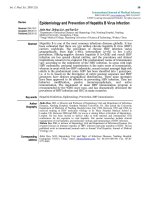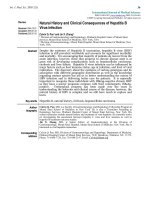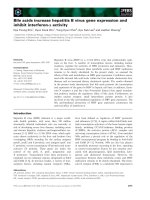Báo cáo y học: "Natural History and Clinical Consequences of Hepatitis B Virus Infection"
Bạn đang xem bản rút gọn của tài liệu. Xem và tải ngay bản đầy đủ của tài liệu tại đây (193.64 KB, 5 trang )
Int. J. Med. Sci. 2005 2(1)
36
International Journal of Medical Sciences
ISSN 1449-1907 www.medsci.org 2005 2(1):36-40
©2005 Ivyspring International Publisher. All rights reserved
Natural History and Clinical Consequences of Hepatitis B
Virus Infection
Review
Received: 2004.10.01
Accepted: 2005.01.02
Published:2005.01.05
Calvin Q. Pan
1
and Jin X. Zhang
2
1
Division of Gastroenterology and Hepatology, Elmhurst Hospital Center of Mount Sinai
Services, Mount Sinai School of Medicine, New York, USA
2
Division of Gastroenterology, Mount Sinai Hospital, Mount Sinai School of Medicine, New
York, USA
A
A
b
b
s
s
t
t
r
r
a
a
c
c
t
t
Despite the existence of Hepatitis B vaccination, hepatitis B virus (HBV)
infection is still prevalent worldwide and accounts for significant morbidity
and mortality. It is encouraging that majority of patients do recover from the
acute infection, however, those that progress to chronic disease state is at
great risk of developing complications such as hepatocellular carcinoma,
cirrhosis and liver failure. Hepatitis B virus infection can be influenced by
many factors such as host immune status, age at infection, and level of viral
replication. The discovery about the existence of various genotypes and its
association with different geographic distribution as well as the knowledge
regarding mutant species has aid us in better understanding the nature of
HBV infection and in delivering better care for patients. It is especially
important to recognize those individuals with HBeAg-negative chronic HBV
as they have a poorer prognosis compare with their counterparts, HBeAg-
positive. Tremendous progress has been made over the years in
understanding the behavior and clinical course of the disease; however, the
natural history of HBV is complex and we still have much to explore and
learn.
K
K
e
e
y
y
w
w
o
o
r
r
d
d
s
s
Hepatitis B, natural history, cirrhosis, hepatocellular carcinoma
A
A
u
u
t
t
h
h
o
o
r
r
b
b
i
i
o
o
g
g
r
r
a
a
p
p
h
h
y
y
Calvin Q. Pan, MD, is a Faculty of Gastroenterology and Hepatology Fellowship Program at
Mount Sinai School of Medicine in New York. He is also a Consultant Attending at
Hepatology Services, Elmhurst Hospital Center of Mount Sinai Services, New York. His
current researches include natural history and treatment of viral hepatitis. He currently works
on investigating the association between hepatitis C virus and liver steatosis as well as
hepatitis B treatment outcome studies.
Jin X. Zhang, MD, is Senior Fellow of Gastroenterology at the Division of
Gastroenterology, Mount Sinai Hospital, Mount Sinai School of Medicine, New York. She is
interested in viral hepatitis researches.
C
C
o
o
r
r
r
r
e
e
s
s
p
p
o
o
n
n
d
d
i
i
n
n
g
g
a
a
d
d
d
d
r
r
e
e
s
s
s
s
Calvin Q. Pan, MD, Division of Gastroenterology and Hepatology, Department of Medicine,
Elmhurst Hospital Center of Mount Sinai Services, 79-01 Broadway, Elmhurst, NY, 11373,
Phone: 714-888-7728, Fax: 718-888-2147, Email:
Int. J. Med. Sci. 2005 2(1)
37
1. Background
Despite the presence of hepatitis B vaccine, new HBV infection remains common. Primary HBV infection in susceptible
individuals can be either symptomatic or asymptomatic, the latter being often the case, especially in young individuals; but rarely,
fulminant hepatitis can develop during acute phase. Most primary infections are self-limited with clearance of virus and
development of immunity. However, an estimated 3% to 5% of adults and up to 95% of children develop chronic HBV infection.
Persistent infection can also be either symptomatic or asymptomatic; those with elevated liver chemistries and abnormal biopsies are
termed as having chronic hepatitis B and those with normal studies are labelled as chronic HBV carriers. Long-term infection
increases risk of developing cirrhosis and HCC.
2. HBV Genotypes and Mutants
DNA sequence of HBV isolates has shown the existence of 8 viral genotypes A-H and these varies in geographic distribution
(Table 1). Genotype A is found primarily in North America, Northern Europe, India, and Africa. Genotype B and C are common in
Asia; genotype D, in southern Europe, the Middle East, and India; genotype E, in West Africa and South Africa; genotype F, in
South and Central America; genotype G, in the United States and Europe [1]. Genotype H was recently identified in individuals
from Central America and California [2]. Several genotypes may be associated with the severity of the disease but the relationship
between the genotype and the developing hepatocellular carcinoma has not been established. In China and Japan, some studies have
found more severe liver disease to be associated with genotype C than compare with genotype B [3], other studies have found no
such association [4,5]. There is some evidence that shows HBeAg seroconversion occurs at a younger age among individuals
infected with genotype B [3, 5, 6]. Genotype D has been associated with anti-HBe-positive chronic hepatitis B infection in the
Mediterranean region [7].
Table 1. Genotypes of HBV and Geographic Distribution
HBV has a reported mutation rate of 10 times greater compare with other DNA
viruses. These mutations can occur naturally as well as due to selective pressure
from antiviral therapy. There are five clinically relevant HBV types: wild-type
HBV, precore mutants, core promoter mutants, tyrosine-methionine-aspartate-
aspartate (YMDD) mutants induced by lamivudine treatment, and asparagine to
threonine (rtN236T) mutants recently identified in patients with adefovir treatment.
In a study carried out in the United States, the precore variant of HBV was rarely
found in association with genotype A, but it was found in almost 50% of those with
genotype C and in >70% of individuals with genotype D. Those with precore variant
and core promoter mutations had higher HBV DNA levels in sera than those persons
without these mutations. It is observed that flares in chronic HBV have been
associated with increases in concentrations of precore mutation in proportion to wild-
type HBV. Exacerbations have been thought to subside with time when the genetic
heterogeneity disappears and patients become exclusively infected with precore HBV
[8]. During the treatment of chronic hepatitis B by lamivudine, drug resistance may develop, which is mediated by point mutations
with the YMDD motif at the catalytic center of the viral reverse transcriptase. With increase in the mutant viral load, patients can
sustain further liver injury. The YMDD mutant level will decrease after stopping lamivudine. Viral mutation also occurs in patients
on adefovir treatment during their second year therapy at the rate of 2.5%. The mutation has been reported as asparagine to
threonine mutation (rtN236T), downstream of the YMDD motif. It is not clear yet if rtN236T mutant can induce further liver
damage.
3. HBV Transmission and Vaccination
Perinatal or horizontal infection early in childhood are the main routes of HBV transmission in high endemic region, such as
Asia, Africa, Pacific Islands and the Arctic and the rate of HBsAg positivity ranges from 8% to 15%. In the low endemic area, such
as Western countries, HBV is predominantly a disease of adolescents and adults as a result of high risk sexual behavior or injection
drug use and the rate of HBsAg positivity is less than 2% [9]. HBV infection frequently is waxing and waning, it goes through
alternating cycles of replicative and non-replicative phases.
Since the availability of hepatitis B vaccination in 1982, it has had some dramatic impact on the outcome of liver disease. For
example, in Alaska, the proportion of HBV carriers who were HBsAg positive in the population declined from 35% to 3% in 15
years after the introduction of the vaccination program in newborns and the completion of a mass vaccination catch up program [10].
In Taiwan, the universal hepatitis B vaccination in newborns has both dramatically decreased prevalence of HBsAg as well as
incidence of HCC in this age group.
4. Stages of HBV Infection
An individual can develop hepatitis B infection that is acute and achieve complete immune clearance of virus yielding lifelong
immunity; however, an alternate fate of the host is the development of chronic hepatitis B. There are three stages of HBV infection
based on viral-host interaction, namely, the immune tolerant phase, the immune clearance phase, and the inactive carrier phase with
or without reactivation (Fig 1.). After acute infection of HBV, some patients may remain HBeAg positive with high levels of serum
HBV DNA, little or no symptoms, normal ALT levels and minimal histological activity in the liver, this phenomenon is known as
the immune tolerance phase. This phase is typical of infection in children and young adults. It usually lasts for 2-4 weeks, but can
last for years in those who acquired the infection during the perinatal period [11]. Individuals in this group are highly contagious
and can transmit HBV easily. When the tolerogenic effect is lost during the immune tolerant phase, immune-mediated lysis of
infected hepatocytes become active and patients enter the second stage defined as immune clearance phase, the HBV DNA level
Genotype Geographic Distribution
A Africa, India, Northern
Europe, United States
B Asia, United States
C Asia, United States
D India, Middle East,
Southern Europe, United
States
E West and South Africa
F Central and South America
G Europe, United States
H Central and South America,
California in United States
Int. J. Med. Sci. 2005 2(1)
38
decreases and ALT level increases. The duration of clearance phase lasts from months to years. This is followed by the carrier stage,
in which seroconversion of HBeAg to HBeAb occurs, HBV DNA becomes non-detectable or at low level and ALT is usually
normal, reflecting very low or no replication of HBV and mild or no hepatic injury. The inactive carrier stage may last for years or
even lifetime. Patients in this stage can have spontaneous resolution of hepatitis B and develop HBsAb, but a portion of them may
undergo spontaneous or immunosuppression-induced reactivation of chronic hepatitis, featuring elevated ALT, high level of DNA,
moderate to severe liver histological activity, and with or without HBeAg seroreversion.
5. Clinical Spectrum of HBV Infection
Primary Infection –Subclinical Infection and Acute hepatitis B. Majority of HBV infection in children are subclinical
versus those in adults, about 30% to 50% develop acute icteric hepatitis. Those who recover should acquire lifelong immunity.
However, a subset of patients will be chronically infected and very few patients (0.1% - 0.5%) can develop fulminant hepatitis. In
primary infection, HBsAg becomes detectable after 4 to 10 weeks of incubation period, followed by antibodies against the core
antigen (HBcAb) in IgM form during early period [2]. Viremia is well established by the time HBsAg is detected (usually from
10^9 to 10^10 per milliliter) [12]. Circulating HBeAg becomes detectable in most cases. When liver injury occurs in acute
infection, alanine aminotransferase levels do not increase until after viral infection is well established, reflecting the time required to
generate the T-cell-mediated immune response that triggers liver injury. Once this response has commenced, viral titer in blood and
liver begins to drop. With clearance of the infection, HBsAg and HBeAg disappear, and free HBsAb become detectable. Presence
of HBsAg, HBeAg, and high DNA level for greater than 6 months implies progression to chronic infection. When persistent
infection establishes, the serology markers like HBeAg, HBeAb and HBsAb can be positive or negative except HBsAg and HBcAb
(IgG form) remain positive.
HBeAg positive chronic hepatitis B. Age at the time of infection is a strong determinant of chronicity, the earlier the
acquisition of infection, the higher probability of developing chronic infection. Levels of viremia in chronic infection are generally
significantly lower than during primary infection. In adult acquired disease, the early phase of infection often is accompanied by
significant disease activity with elevated ALT levels versus those who acquired the infection perinatally usually have normal ALT
levels. Many patients with perinatal infection enter the immunoactive phase and develop HBeAg positive chronic hepatitis with
elevated ALT levels only after 10-30 years of infection [13]. A key event in natural history of progression is HBeAg seroconversion
to HBeAb with marked reduction of HBV replication followed by gradual histological improvement [14]. In studies, the observed
clearance of HBeAg is about 50% and 70% within 5 and 10 years of diagnosis respectively [9]. Most studies found the mean annual
rate of spontaneous seroconversion is 8% to 15% in individuals with active liver disease, but those with normal ALT levels tend to
have smaller annual conversion rate of 2% to 5%.
HBeAg negative chronic hepatitis B. A proportion of patients who undergo HBeAg seroconversion demonstrate a recurrence
of high HBV DNA levels and intermittent or persistent ALT level elevations. These individuals have a naturally occurring mutant
form of HBV that does not produce HBeAg, due to a mutation in the precore or core promoter region. Most frequent precore
mutation is a G-A change at nucleotide 1896 (G1896A) which creates a stop codon and results in loss of HBeAg synthesis; the most
common core promoter mutation involves a 2 nucleotide substitution at nucleotide 1762 and 1764 [15]. HBeAg-negative carriers
are a heterogeneous group and most of them have low viral DNA levels, relatively normal levels of alanine aminotransferase, and a
fair prognosis. However, in Asia, Middle East, Mediterranean basin and southern Europe, about 15% to 20% of these carriers have
elevated alanine aminotransferase and viral DNA [16]. HBeAg-negative chronic hepatitis B (precore mutant) emerges as the
predominant species during the course of typical HBV infection with wild-type virus and is selected during the immune clearance
phase (HBeAg seroconversion) [17]. The development of HBeAg-negative chronic hepatitis B can occur either close to HBeAg
seroconversion or decades later. There are 2 main patterns of disease activity in this subgroup of patients: 30%-40% of patients
experience persistent elevated ALT levels (3-4 folds) and the remaining 60%-70% patients can have erratic ALT patterns with
frequent flares. Sustained spontaneous remission is rare (6% to 15%) in these individuals, and spontaneous HBsAg clearance is only
about 0.5% per year [18]; hence, long-term prognosis is poorer among HBeAg-negative individuals than compare with their
counterparts who are HBeAg-positive.
Inactive HBsAg carrier state. Inactive HBsAg carrier state is diagnosed by HBeAg negativity with anti-HBe positivity,
undetectable or low HBV DNA level, repeatedly normal ALT, and normal or minimal histological evidence of damage [19]. The
prognosis of the inactive carrier is generally good and well supported by long-term follow-up studies [20, 21, 22]. An estimated
20% to 30% of HBsAg carriers may develop reactivation of hepatitis B with elevation of biochemical levels, high serum DNA level
with or without sero-reversion to HBeAg. Recurrent episodes of reactivation or sustained reactivation can occur and contribute to
progressive liver disease and decompensation. Frequently, HBV reactivation is usually asymptomatic, but it may mimic acute viral
hepatitis. On the other hand, some carriers eventually become HBsAg negative and develop HBsAb. It is reported that the
incidence of delayed HBsAg clearance is close to 1% to 2% per year in Western countries, but only 0.05% to 0.8% per year in
endemic areas where infection was often acquired during childhood. Apparently, women and older carriers have higher clearance of
HBsAg. Reactivations of HBV replication in patients who receive immunosuppressive therapy or cytotoxic chemotherapy have
been reported in the range of 20% to 50% in chronic carriers [23, 24]; from experience, the combined use of corticosteroid in
chemotherapies significantly increases the risk of reactivation [23]. However, these flares in the immunosuppressed individuals
rarely result in significant hepatic decompensation.
6. Long-term Sequelae of Chronic Hepatitis B
Cirrhosis
Following the diagnosis of chronic hepatitis B, the survivals in these patients are estimated to be 100% at 5 years. However,
cirrhosis and hepatoma are two major long-term complications of chronic HBV infection that significantly increases morbidity and
mortality. In patients without cirrhosis, if untreated, the incidence of liver related death is low and ranges from 0 to 1.06 per 100
person years. The mortality rate at 5 years is 16% for those with compensated cirrhosis and is 65% to 86% for decompensated
cirrhosis [25, 26]. In untreated individuals with predominantly HBeAg positive chronic hepatitis B, the incidence of cirrhosis ranges
Int. J. Med. Sci. 2005 2(1)
39
from 2 to 5.4 per 100 person years with a 5-year cumulative incidence of cirrhosis of 8% to 20% [9]. A higher rate of cirrhosis has
been reported in HBeAg-negative as compared to HBeAg-positive patients. Also, older age and persistent viral replication are
predictors for development of cirrhosis as well as mortality. Genotype C is associated with a higher risk of cirrhosis than genotype
B based on studies in Asian patients [27]. The presence of any other independent hepatotoxic factors such as alcohol ingestion,
HCV co-infection can contribute to progression to cirrhosis. Once cirrhosis is established, individuals can decompensate over time.
In the EUROHEP cohort study, the 5-year cumulative incidence of hepatic decompensation was 16%, the incidence per 100 person
years was 3.3 and the mean interval between the time of diagnosis of cirrhosis and the onset of first episode of decompensation was
31 months (range 6-109) [28]. After decompensation, the survival drops to 55% to 70% at 1 year and to 14% to 28% at 5 years;
Interestingly, an improvement in liver function activity has been observed in those individuals who subsequently lose their HBsAg
positivity.
Hepatocellular Carcinoma
The development of hepatocellular carcinoma (HCC) and liver failure are main cause of death from chronic hepatitis B.
Various factors involving the host and the virus may contribute to the development of hepatocellular carcinoma (Table 2). It is
estimated that over 500,000 people die each year from the consequence of HBV infection [9]. HCC incidence is three to six times
higher in males than in females, suggesting a tumorigenic effect of androgens [10, 29]. Several studies have indicated that older age
(>45 years) is an important determinant of HCC, this may either reflect a longer duration of viral infection and liver disease or age
may be an independent risk factor. Having a first degree relative with HCC, the presence of cirrhosis, and reversion activity are all
thought to contribute to HCC development [10, 29, 30, 31]. Chronically infected subjects have a 100 times increased risk of
hepatocellular carcinoma compare with non-carriers [20]. A recent study suggested positive HBsAg increased one’s risk of
developing HCC by 10 folds, and with positive HBeAg, HCC is significantly increased by 60 folds. Moreover, a detectable HBV
DNA level yields a 4 fold increase risk of HCC [32]. The additional use of alcohol, consumption of aflatoxin in diet and co-
infection with HCV or HDV are independent factors for HCC in HBV infected patients. Unlike hepatitis C, development of HCC in
hepatitis B patients does not require preceding cirrhosis. Hence, it is advocated that all HBV infected patients, regardless of
cirrhosis status, should get screening for HCC every 6 months with alpha-fetoprotein (AFP) and liver sonogram. Currently, there is
no consensus as to when such screening should commence, but it is reasonable to start screening immediately once these patients
seek medical attention.
Table 2. Independent Risk Factors for the Development of HCC in HBV infection
7. Conclusion
It has been encouraging to witness the recent discoveries in HBV infection
with insights into the existence of genotype subgroups, mutant variants,
knowledge regarding host, viral and environmental factors on the disease course,
as well as advances in new treatment modalities. However, despite the much
progress in understanding the natural history of HBV infection, we still have a
long way to go before we can conquer hepatitis B infection. For instance, more
studies are needed to clarify whether there is an association between genotype,
mutant variants and the development of hepatocellular carcinoma. In the
HBeAg-positive subgroup, there still lacks a consensus on how to manage these
patients when they present with signs of mild liver disease activity with alanine
aminotransferase less than 2 fold increase; future studies with longer follow-up
may help us gain knowledge about the HBV behavior in these individuals. There is much more to be understood about mutations
and their impacts on the clinical course and long-term outcome of hepatitis B infection. For instance, it has been suggested that
mutations can arise from vaccine-induced antibodies and this renders the immune response generated by the vaccination ineffective.
Therefore, mutations may play a key role in the difficulties of managing hepatitis B infection. Hence, further research and
understanding in this sector may bring exciting new information and better understanding of the natural history of HBV and
supplement our existing armamentarium to combat this persistent worldwide prevalent disease.
Conflict of interest
Dr. Pan is on the panel of speaker’s bureau for Novartis Pharmaceuticals USA and received research grand support from
Schering-Plough Corporation. Dr. Zhang has no disclosable financial arrangements or interest with any corporations.
References
1. Kidd-Ljunggren K, Miyakawa Y, et al. Genetic variability in hepatitis B viruses. J Gen Virol 2002;83:1267-1280.
2. Arauz-Ruiz P, Norder H, Robertson BH, et al. Genotype H: A new meridian genotype of hepatitis B virus revealed in Central America. J
Gen Virol 2002;83:2059-2073.
3. Kao JH, Chen PJ, Lai MY, Chen DS. Genotypes and clinical phenotypes of hepatitis B virus in patients with chronic hepatitis B virus
infection. J Clin Microbiol 2002;40:1207-1209.
4. McMahon BJ, Holck P, Bulkow L, et al. Serologic and clinical outcomes of 1536 Alaska natives chronically infected with hepatitis B virus.
Ann Internal Med 2001;135:759-768.
5. Sumi H, Yokosuka O, Seki N, et al. Influence of hepatitis B virus genotypes on the progression of chronic hepatitis B liver disease.
Hepatology 2003;37:19-26.
6. Chu CJ, Lok ASF. Clinical significance of hepatitis B virus genotypes. Hepatology 2002;35:1274-1276.
7. Chu CJ, Keeffe EB, Han SY, et al. Prevalence of HBV precore/core promoter variants in the United States. Hepatology 2003;38:619-628.
8. Perrillo RP. Acute flares in chronic hepatitis B: The Natural and unnatural history of an immunologically mediated liver disease.
Gastroenterology 2001;120:1009-1022.
9. Fattovich G. Natural history of hepatitis B. Journal of Hepatology 2003, 39: S50-S58.
Types Risk Factors
Male
Older age (>45 years old)
Host
First degree relatives with HCC
HBeAg positive
Detectable HBV DNA
Cirrhosis
Clinical
Persistent HBV infection
(HBsAg positive)
Coinfection with HCV or HDV
Alcohol intake
Viral and
environmental
Aflatoxin in Diet
Int. J. Med. Sci. 2005 2(1)
40
10. McMahon BJ, Alberts SR, Wainwright RB et al. Hepatitis B-related sequelae. Prospective study in 1400 hepatitis B surface antigen-positive
Alaska Native carriers. Arch Intern Med 1990;150:1051-4.
11. Merican I, Guan R, Amarapuka D et al. Chronic hepatitis B virus infection in Asian countries. Journal of Gastroenterology and Hepatology
2000; 15: 1356-1361.
12. Hoofnagle JH. Serologic markers of hepatitis B virus infection. Annu Rev Med 1981;32:1-11.
13. Ribeiro RM, Lo A, Perelson AS, et al. Dynamics of hepatitis B virus infection. Microbes Infect 2002;4:829-35.
14. Lok ASF, Lai CL, Wu PC, et al. Spontaneous hepatitis B e antigen to antibody seroconversion and reversion in Chinese patients with chronic
hepatitis B virus infection. Gastroenterology 1987;92:1839-43.
15. Bortolotti F, Cadrobbi P, Crivellaro C, et al. Long-term outcome of chronic type B hepatitis in patients who acquire hepatitis B virus infection
in childhood. Gastroenterology 1990;99:805-10.
16. Funk ML, Rosenberg DM, Lok ASF. World-wide epidemiology of HBeAg-negative chronic hepatitis B and associated precore and core
promoter variants. J Viral Hepat 2002;9:52-61.
17. Keefe Emmet, Dieterich Douglas, Steve-Huy B, et al. A treatment Algorithm for the management of Chronic Hepatitis B Virus Infection in
the United States. Clinical Gastroenterology and Hepatology 2004;2:87-106.
18. Papatheodoridis GV, Manesis E, Hadziyannis SJ, et al. The long-term outcome of interferon-Alpha treated and untreated patients with
HbeAg-negative chronic hepatitis B. J Hepatol 2001;34:306-13.
19. Lok ASF, McMahon BJ. Chronic hepatitis B. Hepatology 2001;34:1225-41.
20. Hsu YS, Chien RN, Yeh CT, et al. Long-term outcome after spontaneous HBeAg seroconversion in patients with chronic hepatitis B.
Hepatology 2002;35:1522-7
21. De Franchis R, Meuccie G, Vecchi M, et al. The Natural history of asymptomatic hepatitis B surface antigen carriers. Ann Intern Med
1993;118:191-4.
22. Bellentani S, Dal Molin G, Miglioli L, et al. Natural history of HBV infection: a 9 years follow-up of the Dionysos cohort. J Hepatol
2002;36(Suppl. 1):228.
23. Rossi G, Pelizzari A, Motta M, et al. Primary prophylaxis with lamivudine of hepatitis B virus reactivation in chronic HBsAg carriers with
lymphoid malignancies treated with chemotherapy. Br J Hematol 2001; 115:58-62
24. Chan TM, Fang GX, Tang CSO, et al. Preemptive lamivudine therapy based on HBV DNA level in HBsAg-positive kidney allograft
recipients. Hepatology 2002; 36:1245-52.
25. de Jongh FE, Janssen HL, de Man RA, et al. Survival and prognostic indicators in hepatitis B surface antigen-positive cirrhosis of liver.
Gastroenterology 1992;103:1630-1635.
26. Fattovich G, Giustina G, Schalm SW, et al. Occurrence of hepatocellular carcinoma and decompensation in western European patients with
cirrhosis type B. Hepatology 1995;21:77-82.
27. Kao JH, Chen PJ, Lai MY, et al. Hepatitis B genotypes correlate with clinical outcomes in patients with chronic hepatitis B.
Gastroenterology 2000;118:554-9.
28. Fattovich G, Pantalena M, Zagni I et al. Effect of hepatitis B and C virus infections on the natural history of compensated cirrhosis: a cohort
of 297 patients. Am J Gastroenterology 2002;97:2886-95.
29. Beasley RP. Hepatitis B virus. The major etiology of hepatocellular carcinoma. Cancer 1988;61:1942-56.
30. Benvegnue L, Fattovich G, Noventa F et al. Concurrent hepatitis B and C virus infection and risk of hepatocellular carcinoma in cirrhosis.
Cancer 1994;74:2442-8.
31. Tsai JF, Jeng JE, Ho MS, Chang WY et al. Effect of hepatitis C and B virus infection on risk of hepatocellular carcinoma: a prospective
study. Br J Cancer 1997;76:968-74.
32. Yang HI, Lu SN, et al. Hepatitis B e antigen and the risk of hepatocellular carcinoma. N Engl J Med 2002;347:168-174.
Figures
Figure 1. Stages of HBV infection based on virus-host interaction. In persistent infected patients, the stages of immune tolerance
and immune clearance clinically present as HBeAg positive chronic hapatitis B. The stage of inactive phase clinically presents as
HBsAg carrier. * During the stage of reactivation, majority of patients remain HBeAg negative with positive HBeAb and their
clinical presentation can be HBeAg negative chornic hepatitis B, but some patients may have seroreversion of HBeAg and present as
HBeAg positive chornic hepatitis B.
Immune
Tolerance
Immune Clearance
Inactive phase
(HBsAg Carrier)
Reactive phase
HBeAg Positive HBeAg Negative/HBeAb Positive *
HBsAg Positive
Liver Histologic Activity
Mild
Moderate/Severe
None/Mild
Moderate/Severe









